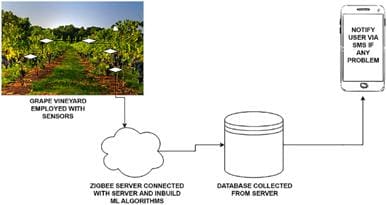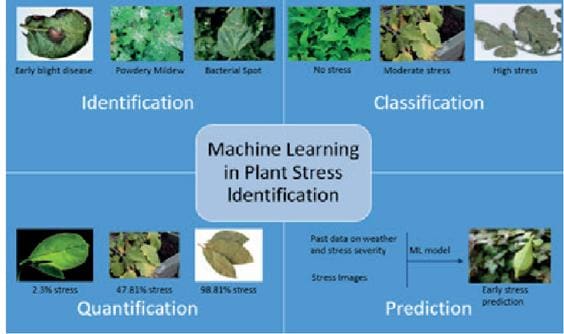Scope and Impact of AI in Agriculture
The major advantage of focusing on AI-based methods is that they tackle each of the challenges faced by farmers from seed sowing to harvesting of crops separately and rather than generalising, provide customised solutions to a specific problem.
By Yogita Kinha, Consultant and Blogger
The Green Revolution during the 1950s and 1960s remarkably drove up the global food production around the world, saving a billion people from starvation. The revolution led to the adoption of new technologies like high-yielding varieties (HYVs) of cereals, chemical fertilizers and agro-chemicals, better irrigation and mechanization of cultivation methods.
India followed suite and adopted the use of hybrid seeds, machine, fertilisers and pesticides. While these practices solved the food shortage problem, they created some problems too in terms of excessive use of fertilisers and pesticides, depletion of ground-water, soil degradation etc. These problems were exacerbated by lack of training to use modern technology and awareness about the correct usage of chemicals etc.
According to the UN Food and Agriculture Organization, the global population will increase by 2 billion by 2050. With limited arable land available and exponentially increasing mouths to feed, we’re now in need of a second Green Revolution. A Green Revolution that is smarter, agile & environmentally conscious — a Green Revolution driven by big data, Internet of Things (IoT), artificial intelligence (AI), and machine learning.
Some of the challenges faced by farmers from seed sowing to harvesting of crops are as follows:
- Crop diseases infestations
- Lack of storage management
- Pesticide control
- Weed management
- Lack of irrigation and drainage facilities.
The major advantage of focusing on AI-based methods is that they tackle each problem separately and rather than generalising, provide customised solutions to a specific problem.
Potential AI application and development areas
- Predictive and Recommendation Analytics — AI and Machine learning can help farmers by recommending the sowing dates for different crops based on weather conditions. ML models can also suggest tweaks in cropping patterns to boost yields. Using the historic production data, weather forecasts, seed information, and demand and supply information, ML can be used to forecast the amount of seed that should be grown to fulfil the growing needs.
- Supply Chain management- AI can be used to predict the demand by analysing inputs like rate of population growth, historical demand patterns of food commodities, region wise staple food patterns, among other inputs. This information can be used to efficiently modify the cropping patterns and also minimise wastage of crop yields and increase profits to farmers.
- Identifying Plant Diseases — Crop images are analysed using computer vision technology and segmented into areas like background, healthy part and diseased part. The diseased part is then captured and sent to remote labs for further diagnosis.
- Detecting pest infestations — Similarly, the leaf images pre-processing help early detection of pests infestation and allow farmers to act quickly and minimise losses.
- Soil Health Monitoring — ML and Deep learning applications are used to identify potential defects and nutrient deficiencies in the soil. The algorithms analyse the soil samples and correlate particular foliage patterns with certain soil defects, plant pests and diseases.
There is considerable progress in this direction globally
Farmers are deploying robots, ground-based wireless sensors, and drones to assess growing conditions. Many researchers and pilot projects have been conducted to test the implications of the involvement of AI applications in improving agriculture.
- Song and He (2005) carried out a research to develop intelligent and carry-home diagnosis expert system (ES) based on Artificial neural networks to detect crop nutrition disorders in time. The field validation indicated that the prediction errors were less than 8%.!!
- Shahzadi et al. (2016) conducted research to develop an expert system to discriminate weed from crops with the help of image analysis and neural networks. Out of the 100 farmers who participated in the trial of this system, 65 were satisfied.
- Arif et al. (2012) developed two ANN models to estimate soil moisture in Paddy fields with limited meteorological data and estimated soil moisture with R2 values of 0.80 and 0.73 for training and validation processes, respectively, Thus, the ANN model reliably estimates soil moisture with limited meteorological data.
- Researchers Patil and Thorat (2016) developed a ML-based system which predicted grape disease beforehand. The system also suggests the pesticides to use to avoid the spread of the disease.

Many big organisations and start-ups are working on to develop applications and IOT enables devices to deploy AI applications to help farmers on a large scale.
- Microsoft in collaboration with the International Crop Research Institute for the Semi-Arid Tropics (ICRISAT), has developed an AI-Sowing App. The app sends sowing advisories to farmers on the optimal date to sow. The farmers don’t need to install any sensors in their fields or incur any capital expenditure. All they need is a feature phone capable of receiving text messages. The pilot project uses an AI sowing app to recommend sowing date, land preparation, soil test-based fertilization, farmyard manure application, seed treatment, optimum sowing depth and more to farmers which has resulted in 30% increase in average crop yield per hectare
- Microsoft in yet another initiative has collaborated with United Phosphorus Limited to build a Pest Risk Prediction API that leverages AI and machine learning to indicate in advance, the risk of pest attack. Based on the weather condition and crop growth stage, pest attacks are predicted as High, Medium or Low.
- A tech-based company named NatureFresh, based out of USA, is developing technology to predict the amount of time a crop will take t produce a yield. A robotic lens will take close pictures of the plants. The images will flow into an artificial intelligence algorithm that would predict precisely how long it will take for the crop to ripen and be ready to be picked, packed and delivered to the grocery stores. This technology would be able to determine the amount of yield that will be available to sell in the future.
From detecting pests to predicting what crops will deliver the best returns, artificial intelligence can help humanity confront one of its biggest challenges: feeding an additional 2 billion people by 2052, even as climate change disrupts growing seasons, turns arable land into deserts, and floods once-fertile deltas with seawater.
Farmers can use AI to determine the optimal date to sow crops, precisely allocate resources such as water and fertilizer, identify crop diseases for swifter treatment, and detect and destroy weeds. Machine learning makes these activities smarter over time. It can also help farmers forecast the year ahead by using historical production data, long-term weather forecasts, genetically modified seed information, and commodity pricing predictions, among other inputs, to recommend how much seed to sow.
References:
The Future of AI in Agriculture - Intel
A robotic lens zooms in on the yellow flower of a tomato seedling. Images of the plant flow into an artificial...
https://cloudblogs.microsoft.com/2018/11/29/feeding-the-world-with-ai-driven-agriculture-innovation/ https://www.sciencedirect.com/science/article/pii/S2589721719300182
Originally published at https://www.edvancer.in on June 30, 2019.
Bio: Yogita Kinha is a competent professional with experience in R, Python, Machine Learning and software environment for statistical computing and graphics, hands on experience on Hadoop ecosystem, and testing & reporting in software testing domain.
Original. Reposted with permission.
Related:
- Machine Learning in Agriculture: Applications and Techniques
- An easy guide to choose the right Machine Learning algorithm
- Crop Disease Detection Using Machine Learning and Computer Vision

